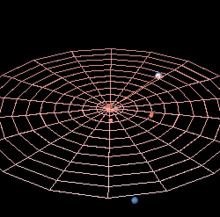Poor Uranus. Besides having a name guaranteed to make 12-year-old-boys giggle, to most people it lacks any sort of interest. It isn’t huge, like Jupiter, or bright, like Venus, or shine with a striking red color, like Mars. It doesn’t have giant glorious rings like Saturn… but it does have rings, and sometimes they can be pretty cool too.
Source: Yes, yes, rings around Uranus, haha
 |
| Uranus presented a featureless disk to Voyager 2 in 1986. en.wikipedia.org |
For centuries, all that was known about the night sky was solely dependent upon the naked eye. Then, in the early 1600s, Galileo Galilei used the telescope for purposes of astronomy. This set the stage for exploration far beyond Galileo's expectations or imagination. The door to the night sky opened!
 |
| Uranus. Image credit: Hubble |
 |
| Uranus has a complicated planetary ring system, which was the second such system to be discovered in the Solar System after Saturn's. en.wikipedia.org |
 |
| Uranus revolves around the Sun once every 84 Earth years. Its average distance from the Sun is roughly 3 billion km (about 20 AU) |
No comments:
Post a Comment